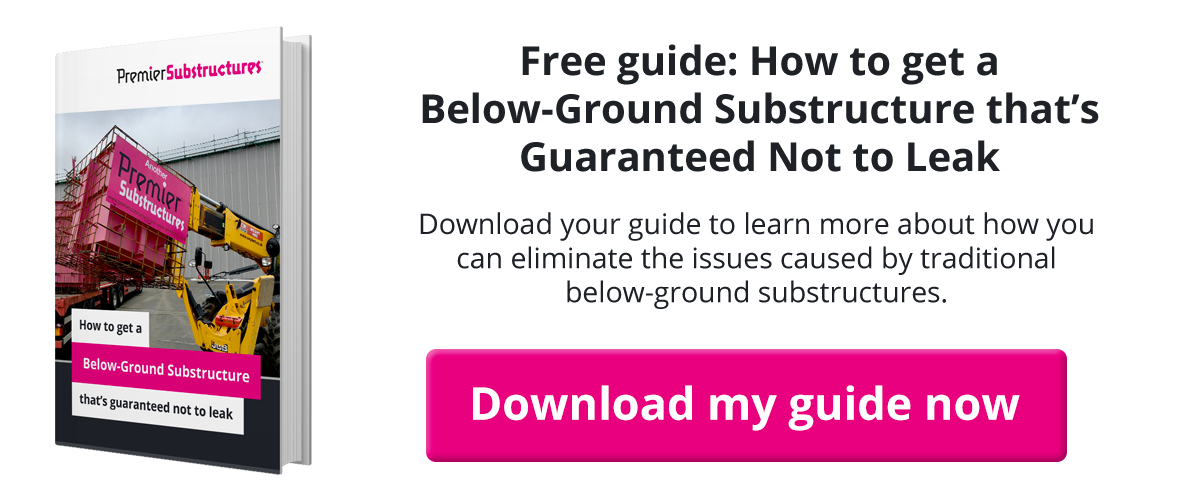Are you looking for a way to improve the quality of future below-ground substructure projects?
There are so many risks and factors to think about when constructing below-ground, and unfortunately (as you may know) this can lead to a poorer quality end-result.
Whether you’re using in situ, or precast concrete to complete your substructure, you’ll come face-to-face with the possibility of leaks (which come from cracking and poor workmanship), poor tolerances, going over time, going over budget, and general poor quality workmanship on site due to unskilled labour.
As you can imagine, all of these factors can lead to the reduced quality of your substructure. So, how can you avoid this from happening?
Well, as a specialist subcontractor, I’m going to explain how you can eliminate the risks above, and increase the overall quality of your substructure builds.
How to increase the quality of your substructure builds
One of the biggest issues that can lead to poor quality in a below-ground substructure comes from building in high water table areas, as the pressure can build up, leading to weakness in the joints getting worse a lot quicker.
Especially when there’s a shortage of skilled labour, below-ground construction can become particularly tricky. There’s also all of the other risks I mentioned above. However, you do have another choice – one that’s not in situ or precast concrete.
I’m talking about prefabricated steel substructures. They’re manufactured entirely out of steel, in an off-site, controlled facility – making for a much cleaner, more organised work environment. The end-result is a completely watertight substructure built to your exact specifications.
This completely eliminates the risk of leaking, and you won’t even have to worry about the risk of installation (as a specialist subcontractor should be happy to do this for you). It even cuts down your time on-site by around 70 – 80% – just with a longer lead time before you begin.
Is prefabricated steel right for your project?
I’m not saying prefabricated steel is always the best choice; it’s not. However, if you need a superior quality substructure that’s built to tight tolerances, with no risk of going over time, or leaks and cracks, prefabricated steel is most likely your best choice.
That is, unless your substructure is on a large scale – say, the size of a tennis court. Then, you’re probably better off with in situ concrete. But you can read more about that option via our recent blog on the subject.
When weighing this method up against your other two options, prefabricated steel is cost comparable – and can often be more competitive than in situ and precast concrete. Although saying that, a lot depends on the shape of your substructure and your requirements.
Advice from a specialist subcontractor
If you aren’t sure if prefabricated steel is the right approach for you, my advice would be to seek out a specialist subcontractor and talk to them about your project. They should be happy to provide you with some free, impartial advice.
We do often have repeat clients who are aware of what we do. Usually, if they require a substructure, they’ll send us the tender drawings to provide them with a quote. They can then get a comparison cost against more traditional methods (in situ or precast concrete).
Because this method reduces on-site time significantly, along with providing a watertight substructure with extremely tight tolerances, main contractors often prefer this alternative approach – or at least the opportunity to weight up the pros and cons of each method.
Unfortunately, an innovative product inherently creates its own disadvantages. For instance, if you aren’t keen to change the method of how you construct, you probably won’t be ready for a prefabricated off-site approach – despite the benefits.
Early adopters, such as Winvic and Northfield – who have been using prefabricated steel substructures for over 10 years – can see the advantages for what they are, and see this method as game-changing for themselves and the end-user.
Conclusion
I hope this blog has been useful when you’re discovering how to increase the quality of your below-ground substructure builds for future projects.
WIth so many factors to take into consideration – such as risks of leaking, going over time, tolerances and general workmanship on-site – prefabricated steel can be a great way to increase the overall quality of your substructure, whilst removing the associated risks.
But only if it’s suitable for your project – and to find that out, I’d recommend contacting a specialist subcontractor so they can advise you further.
Is there anything more specific you’d like to know about prefabricated steel substructures? Just pop me a comment below. I’m always here to help!

